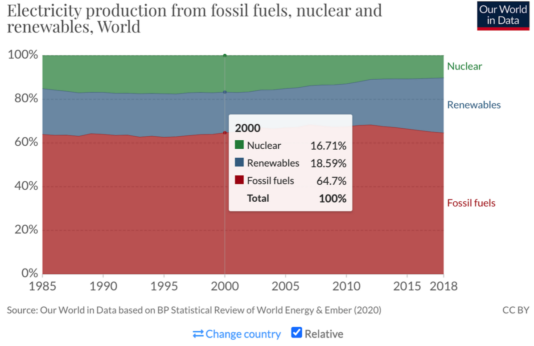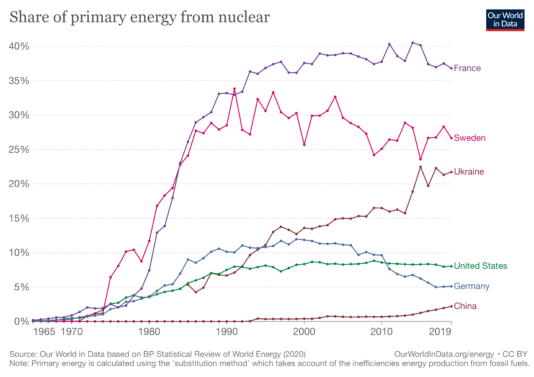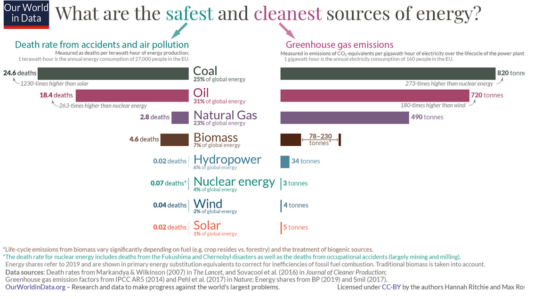- About
- Topics
- Story
- In-Depth
- Picks
- Opinion
- News
- Donate
- Signup for our newsletterOur Editors' Best Picks.Send
Read, Debate: Engage.
| January 20, 2025 | |
|---|---|
| topic: | Energy |
| tags: | #Nuclear energy, #divestment, #fossil fuels, #climate action, #climate change, #green energy, #New Energy Technologies, #Sustainable Development, #renewable energy |
| located: | USA, France, China, Russia, Sweden, Ukraine |
| by: | Gerardo Bandera |
In 2025, nuclear energy generation is expected to hit a record high, according to the International Energy Agency. While it is regarded as one of the safest and cleanest sources of energy in the world, can the controversial power be a reliable solution to the worsening climate crisis?
Nuclear energy is created by the process of nuclear fission - when neutrons are used to split atoms apart, resulting in large releases of radiation and more neutrons, which in turn split more atoms in a controlled chain reaction. Once the atoms are split, the released radiation heats up the water in the nuclear reactor generating steam, which turns a turbine, producing collectable energy.
Light water reactors, the most common nuclear reactors, use uranium-235 because it is relatively unstable enough to split apart easily and releases a lot of energy after nuclear fission. The uranium is placed in water, which controls the reactive process and is turned into steam, which helps generate the electricity.
Uranium-235, however, is highly toxic and releases noxious fumes, and must therefore be handled with expert care. It is also not the most common form of uranium, and must therefore be generated from other isotopes of more commonly found uranium through a process called “enrichment.”
Extracting uranium, however, can be harmful to the environment. It often contaminates the environment with radioactive dust, water-borne toxins, and increased levels of background radiation.
There are newer technologies that use thorium as an alternative source for uranium - it can be converted into uranium in a reactor to generate nuclear energy. While it has been lauded as a more abundant isotope that allows easier handling of nuclear waste, scientists found that the waste from thorium-uranium fuel cycles has similar radioactivity with its plutonium counterparts at 100 years, and even higher longer down the road.
Compared to fossil fuels, nuclear energy is a much more efficient energy source, generating as much energy with 200 tonnes of uranium as is made with 3,500,000 tonnes of coal. Moreover, this amount of energy can be generated by only one tonne of thorium in newer reactors.
In 2023, fossil fuels continued to be the world’s predominant sources of energy, making up 81.5 percent of the world’s energy mix. By contrast, nuclear energy only generated about less than 4 percent of the energy mix. France consumes it the most per capita, followed by Sweden and South Korea, while Japan ranks second when it comes to generation after France.
Some countries have stopped depending solely on fossil fuels for electricity and have turned to renewable sources and nuclear energy instead. In France, for example, nuclear energy produced 67 per cent of its electricity in 2020, while in Sweden, nuclear accounted for 30 per cent and hydropower accounted for 45 per cent of its energy mix.
The terrible accidents of Chernobyl and Fukushima immediately come to mind when people think of nuclear energy. Hundreds of people died, with many exposed to ionising radiation - it can lead to cardiovascular diseases and even death, while some suffered increased risks of thyroid cancer. One should also put into perspective that nuclear energy has caused much less deaths than fossil fuels, but compared to solar energy, it’s still less safe.
Climate change impacts like floods, droughts and typhoons are also creating a new risk for nuclear plants that are mostly located in coastal areas for cooling the reactors.
Since some of the waste from nuclear energy is highly dangerous, effective waste management is crucial, although sometimes costly. There’s also no current technology that can neutralise radioactive waste so storage is the only possible solution, but site identification has created tensions in local communities around the world for its harmful impacts on health.
Although the high and medium level radioactive waste - the remnants of the uranium fuel from within the reactors - accounts for only 5 per cent of total nuclear energy-production waste, they are mostly stored in nuclear plants that are facing increasing climate threats.
Finland has built the world’s first permanent depository for high-level nuclear fuel waste after two decades of excavating, but whether the vessels inside can last for its intended 100,000 years - the period it takes for nuclear waste to be naturally neutralised - will remain to be seen.
Nuclear energy does not give off harmful pollutants and carbon dioxide the way burning fossil fuels does. It therefore does not contribute as much to global warming as other energy sources.
Because of its low-emission rate, nuclear energy results in much less human casualtiescompared to the mortality rate of fossil fuels. By contrast, the WHO estimates that 4.2 million people die each year from pollution caused by burning fossil fuels.
Making the shift to renewable energy as quickly as possible is key to preventing catastrophic man-made climate change, as agreed by all UN countries at COP28 and reinforced in COP29.
Whether the controversial energy source should be alternatives to renewables has become a constant debate. Advocates and consultants say they should be complementary to the current burgeoning trend of installing renewables to further slash emissions.
But green groups say that it can be a “dangerous distraction” to cheaper energy sources like solar that’s safer and cleaner. They add that the much hyped small modular reactors that are cheaper than existing nuclear designs are untested and will take a long time to realise their potential.
By copying the embed code below, you agree to adhere to our republishing guidelines.






